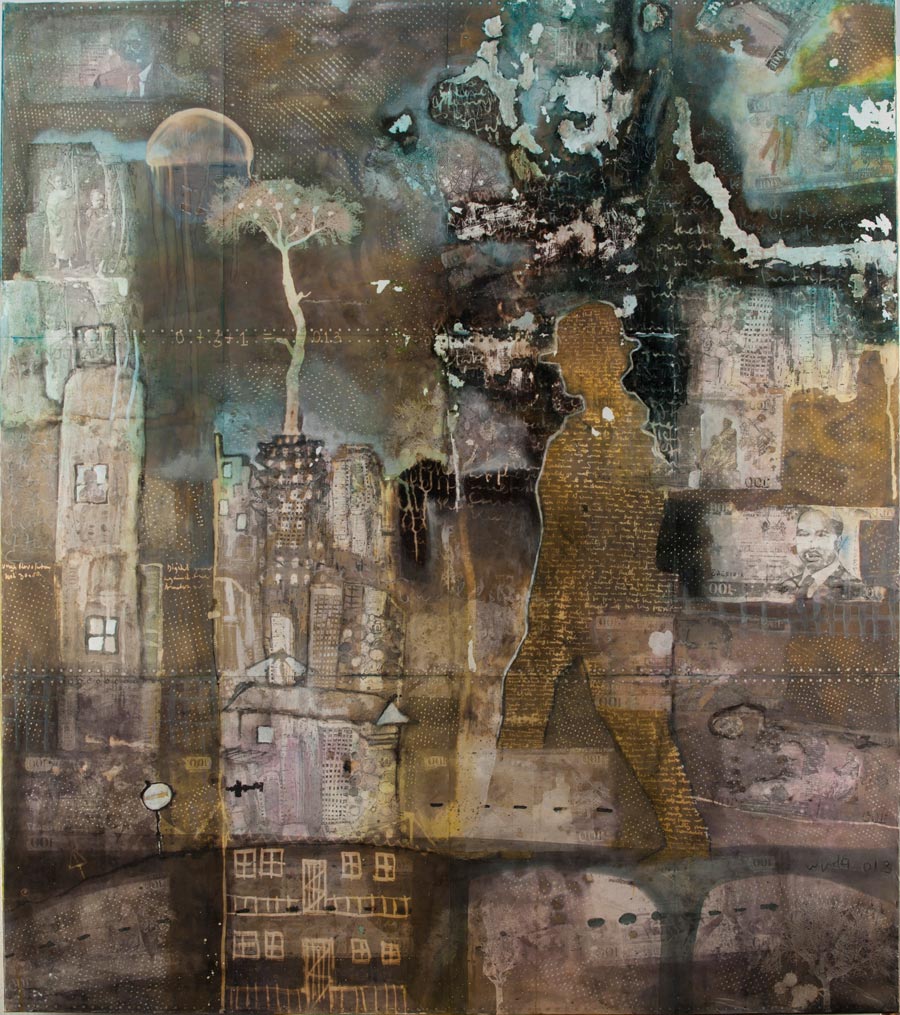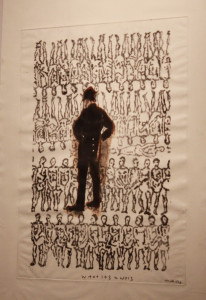
PAUL ONDITI: Notes from a curious mind
Posted: May 1st, 2013 on Addis Rumble, Uncovering African Arts
Mystical, translucent and seductive. The works of Kenyan artist Paul Onditi (1980) are mesmerizing and intriguing. He is one of Kenya’s bright and upcoming contemporary artists who found his own style and voice a long time ago.
Mixing and matching genres, materials, techniques and media is Onditi’s thing. Filmstrips, prints, layers of layers of paint, and a variety of handpicked media-works are patched together in meticulous ways to visualize ideas and imaginative worlds. The result is an intelligent, deep and multi-layered aesthetic that requires deciphering and contemplation beyond the surface.
 Walk.
Walk.
With an impressionistic sensibility and futuristic imagination, Onditi seems to deliberately hit the soft spot of our time, where we at once are longing for a brighter future, and are nostalgic about the less troublesome past. This longing is unveiled in Onditi’s dark and gloomy environments where his signature character ‘Smokey’ moves about. Smokey navigates in a vacuum. He is in between time, place, phases, and positions. And this vacuum is the artists’ ideal place for questioning, research, exploration and manifestation of ideas.
We rounded Onditi up in his studio at the Kuona Trust in Nairobi and had a chat with him about the becoming of an artwork, his significant style and recent success. Read excerpts from the interview below.
 Half Life, 2013.
Half Life, 2013.
————————————————————————————–
You work in mixed media, almost collage-like canvasses patched together by different materials and techniques. How and where do you start an artwork?
First of all it starts with my imagination and idea of how the artwork will take form. Then I determine a technique of how to get what I want. This coupled with technique then, in a nutshell I have the artwork.
I’m a curious person. I’ve tried quite a vast number of materials, from oil paint to acrylic to bio materials. There’s nothing as far as my reach is concerned that I haven’t tried. Well, probably there is. So that means that after imagining what I want, , I execute my artwork by starting to implement different materials and techniques determined by what will work the best.
 Mirage.
Mirage.
You incorporate a lot of media in your work. You find photos, texts, drawings online, copy them to your work etc.?
Depending on the subject matter, I often select from a variety of media. I use very old media releases/imagery to depict a current situation. I do this, because to me, nothing is new to the sun. Whatever we see today, have existed before in one way or the other. So I use this as a point of argument. It is not the first time we have a financial crisis, it has happened before. So I go back to old newspapers to find e.g. currencies that existed in the past to portray the current financial crisis. So it’s a way of showing human behaviour in this recycling circle that keeps repeating.
A mystical, lonely figure appears in most of your work. Who is this figure, and what is his story?
I’ve named this solitary man ‘Smokey’. He is a kind of representation of the state of the human mind. It isn’t necessarily my mind, but more often it is because, he is part of what I do, and what I had imagined before I did it.
The mind of everyone to me is very vague, no matter what or how they may claim their faith. You never know what another person is thinking about. You see them, and you don’t know what is going through their minds. So this vacuum between people in communication is what I’m trying to explore, by putting this visual being whom you cannot quite describe because his face is indescribable, it’s a vacuum, a vague face. That explains why he sometimes is even headless. He is just a representation.
Does your work always evolve around this Smokey character? Is he always present?
One way or the other, you will always find Smokey somewhere in a little corner. I rarely do paintings without Smokey, but if he is not there in person, he is represented in other ways. If you don’t see Smokey, you’ll find mathematics, accumulative mathematics. This covers the same representation as Smokey. It is an attempt to cease the moment of a certain time, and to explore the human mind.
Smokey often walks around in mystical, gloomy, and dark environments that install an almost spiritual sensibility. What role does spirituality and the metaphysical play in your work?
You cannot dissociate the mind completely from the spiritual world. That feeling of a spirit around the mind, it is very essential in that it exists. Now, whether good or bad is debateable. The spirit ‘hanging’ over a painting can be a good or a bad it doesn’t matter. It’s just a reflection of a specific point in time. For me, whatever the occurrence that drove me to the execution of a given piece, remains in the work. For me it’s about freezing the moment and telling it as it is. How I see it or interpret it is how I will show it in the work.
I’ve also noticed your use of urban landscapes. Towers, railway tracks, brick walls, bridges, road nets etc. are your preferred setting. What are you exploring in the urban environments?
You know, for a long time people imagined the so-called ‘African Art’ to be a primitive art with settings in the rural and as huts in the bush. But I live in Nairobi city. I have the same feeling in this city that I have when I go to London or any other major cities of the world. As an artist it is my responsibility to cease the moment right in front of me. I can only tell the story of my time. And the story of my time shows the environment where I live and spend most of my year: the city. To me, life right now evolves around the urban centres.
Another thing that strikes me about your settings is that they juxtapose something both backward and forward looking, something at once impressionistic, contemporary and futuristic. What is your take on that?
In my own interpretation, I tend to visualize things by judging based on the past, and trying to imagine them in the future. I believe that things that has happened before will happen again,. The sun will always rise in the East no matter what. This is not new. And rocket science for instance is not new either. There is a biblical story, the Tower of Babel, that I have constructed a lot of work around. I reason that if people were brought together by the sense of reaching a God in heaven, and thus built a tower to get them there, something similar is happening today. You see, the only time when superpowers like Russia, China and America get together harmoniously, is when they want to go to the moon. Then they speak with one voice because they need each other. And to me, this story is very fascinating.
To imagine a future that is ignorant of the past and the present is vague. And so, as a visual communicator, I always try to imagine or fantasize of the future based on judgements that are done of the past and the present.
 Smokey Plus.
Smokey Plus.
Something characteristic for your work as well is a continuous attempt to build bridges between opponents, between the positive and negative, physical and metaphysical, Africa and Europe. Does this occupy you a lot?
Yes, because as much as we may want to run away sometimes, the reality catches up with us. You know, I’m an artist born in Kenya, in an environment that never taught us to see and appreciate art. Then I trained in Europe where there’s a much higher appreciation and understanding of art. But while being in Germany, I always kept my Kenyan identity close. So then, I decided to use my art to bind worlds together, and for instance I decided to call my art Afro-European, because I see things more or less African and European at the same time. It doesn’t change who I am, but means that I see things as they are here and from different angles.
And what significance has your training and life in Germany had on your career as an artist in Kenya?
It’s had a big impact. I used to see things in a different way. As an African I must admit that we Africans are very literal and less conceptual. As much as I was very literal when I joined the University of Arts in Offenburg, I was still yearning to go conceptual, and somehow strike a balance between the literal and conceptual perceptions, and come up with artwork that had not been tried before. That’s why you’ll see that some of my works are looking a bit naïve and others are deepened into conceptual sides of life.
Life has two sides – a coin is only valid if it has two sides, the head and the tail. So for me the head and the tail is that we sometimes have to be interpretational and sometimes we have to go about life in a literal way. So I take two worlds again, trying to use the conceptual acquired knowledge to blend up an example of what is happening in the world around us. In life as well you have to strike a balance between different sides and opinion by the end of the day. At the end of the day, what I’m trying to express is what is before me.
The last couple of years you have experienced quite a lot of success –you’ve had solo shows in Kenya and will have one in Germany next month. How this success influenced your work?
I believe in creating what I have to create, and this is the only thing that influences me. I go into a work with an inspiration for what I want to do, and this is not determined by demands in the market. Because the demand might be there today, and be gone tomorrow, but that doesn’t mean that I will stop creating tomorrow. What it means is that I keep working as the inspiration is there and the ideas come home. I find it extremely difficult to bend my creativity to fit the needs of others. It doesn’t work for me. My success is driven by a curious mind, a mind that never gets satisfied. I always want to broaden my sight and go that extra mile to try out another thing, and another thing, and another… That’s basically my denominator when it comes to creation. So somehow, me and the market are good friends because of the people who has decided to appreciate my artwork as they found them, and that encourages me.
 Talisman.
Talisman.
ABOUT
Paul Onditi was born and raised in Kenya. After college he went to Germany where he studied arts at the Offenbach University of Arts. He has participated in many group shows in Kenya and Europe and has had several solo-shows in Kenya as well as in Germany. He has been runner up for the Nairobi Provincial Awards twice and he is one of eight Kenyan artists who are invited to the Bonhams Auction in London this year.

